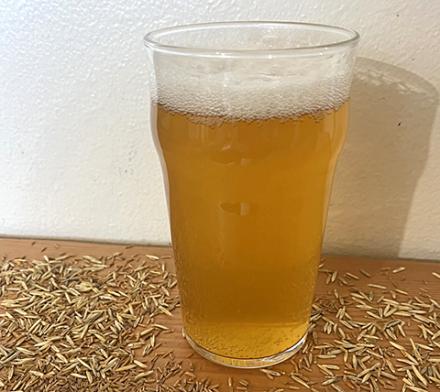Raising a Toast to Kernza

Kernza beer with Kernza grains. (Image courtesy of Alison Hamm, D5100-1)
If you are inclined to consume an adult beverage from time to time, be sure to raise a toast to Kernza.
Kernza is a relatively new grain in the United States and it’s making its way into breweries; early reports are that it’s not only easy on the taste buds, but also good for the environment. That’s because Kernza is a perennial plant. Perennials don’t have to be replanted every year like annual crops, such as wheat and barley, which are traditionally used to brew beer. Reseeding annual plants often requires farmers to till their fields, a practice that is known to cause soil moisture loss and erosion.
Scientists with the Agricultural Research Service (ARS) are participating in a coordinated national research project to develop Kernza, an intermediate wheatgrass (Thinopyrum intermedium). As a crop, it has dual-use flexibility in that it can be harvested for both grain and forage. In addition to brewing, Kernza can be used in many products as a substitute for traditional wheat.
“ARS’s national field trials are coordinated across eight states,” said Peter Kleinman, soil scientist and research leader at the ARS Soil Management and Sugarbeet Research unit (SMSRU) in Ft. Collins, CO.
"For beer lovers, this work is all about quantifying the link between Kernza production with environmental and brewing outcomes, from the bottom of the soil to the bottom of the glass,” said Alison Hamm, biological science aid at SMSRU. Hamm leads a survey of grain quality from breeding programs across the country.
“In the parlance of the Kernza community, this perennial grain ‘tastes great, less tilling,’” she said.
Grace Miner, an ARS postdoctoral researcher at SMSRU, is coordinating soil and water analyses of Kernza and soil health. “The perennial nature of Kernza offers continual cover that protects soil year-round and deep roots that hold the promise of building healthy soils,” she said. “Here in the West, our priority is to understand whether Kernza can help farming communities adapt to a future with less water."
The research partnership is funded, in part, by a $10 million grant from USDA’s National Institute of Food and Agriculture. The Land Institute, a science-based research organization based in Salina, KS, developed Kerna grain as part of its effort to create alternatives to destructive agricultural practices. – by Scott Elliott, ARS Office of Communications

